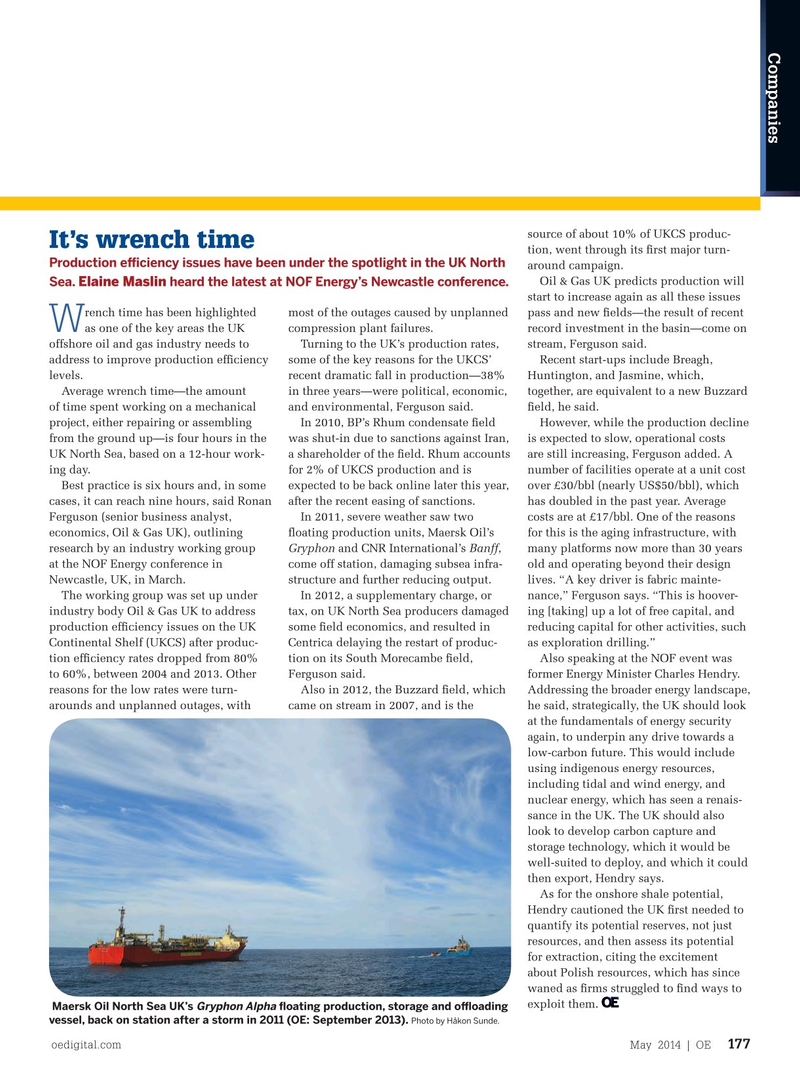
Page 175: of Offshore Engineer Magazine (May/Jun 2014)
Read this page in Pdf, Flash or Html5 edition of May/Jun 2014 Offshore Engineer Magazine
Companies source of about 10% of UKCS produc-
It’s wrench time tion, went through its frst major turn-
Production efciency issues have been under the spotlight in the UK North around campaign.
Oil & Gas UK predicts production will
Elaine Maslin
Sea. heard the latest at NOF Energy’s Newcastle conference.
start to increase again as all these issues rench time has been highlighted most of the outages caused by unplanned pass and new felds—the result of recent
W as one of the key areas the UK compression plant failures. record investment in the basin—come on offshore oil and gas industry needs to Turning to the UK’s production rates, stream, Ferguson said.
address to improve production effciency some of the key reasons for the UKCS’ Recent start-ups include Breagh, levels. recent dramatic fall in production—38% Huntington, and Jasmine, which,
Average wrench time—the amount in three years—were political, economic, together, are equivalent to a new Buzzard of time spent working on a mechanical and environmental, Ferguson said. feld, he said. project, either repairing or assembling In 2010, BP’s Rhum condensate feld However, while the production decline from the ground up—is four hours in the was shut-in due to sanctions against Iran, is expected to slow, operational costs
UK North Sea, based on a 12-hour work- a shareholder of the feld. Rhum accounts are still increasing, Ferguson added. A ing day. for 2% of UKCS production and is number of facilities operate at a unit cost
Best practice is six hours and, in some expected to be back online later this year, over £30/bbl (nearly US$50/bbl), which cases, it can reach nine hours, said Ronan after the recent easing of sanctions. has doubled in the past year. Average
Ferguson (senior business analyst, In 2011, severe weather saw two costs are at £17/bbl. One of the reasons economics, Oil & Gas UK), outlining foating production units, Maersk Oil’s for this is the aging infrastructure, with research by an industry working group Gryphon and CNR International’s Banff, many platforms now more than 30 years at the NOF Energy conference in come off station, damaging subsea infra- old and operating beyond their design
Newcastle, UK, in March. structure and further reducing output. lives. “A key driver is fabric mainte-
The working group was set up under In 2012, a supplementary charge, or nance,” Ferguson says. “This is hoover- industry body Oil & Gas UK to address tax, on UK North Sea producers damaged ing [taking] up a lot of free capital, and production effciency issues on the UK some feld economics, and resulted in reducing capital for other activities, such
Continental Shelf (UKCS) after produc- Centrica delaying the restart of produc- as exploration drilling.” tion effciency rates dropped from 80% tion on its South Morecambe feld, Also speaking at the NOF event was to 60%, between 2004 and 2013. Other Ferguson said. former Energy Minister Charles Hendry. reasons for the low rates were turn- Also in 2012, the Buzzard feld, which Addressing the broader energy landscape, arounds and unplanned outages, with came on stream in 2007, and is the he said, strategically, the UK should look at the fundamentals of energy security again, to underpin any drive towards a low-carbon future. This would include using indigenous energy resources, including tidal and wind energy, and nuclear energy, which has seen a renais- sance in the UK. The UK should also look to develop carbon capture and storage technology, which it would be well-suited to deploy, and which it could then export, Hendry says.
As for the onshore shale potential,
Hendry cautioned the UK frst needed to quantify its potential reserves, not just resources, and then assess its potential for extraction, citing the excitement about Polish resources, which has since waned as frms struggled to fnd ways to exploit them. Maersk Oil North Sea UK’s foating production, storage and ofoading Gryphon Alpha vessel, back on station after a storm in 2011 (OE: September 2013). Photo by Håkon Sunde.
oedigital.com May 2014 | OE 177 000_OE0514_Activity.indd 177 4/19/14 2:07 PM

 174
174

 176
176